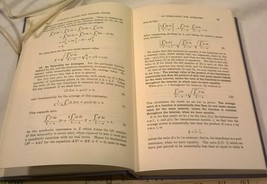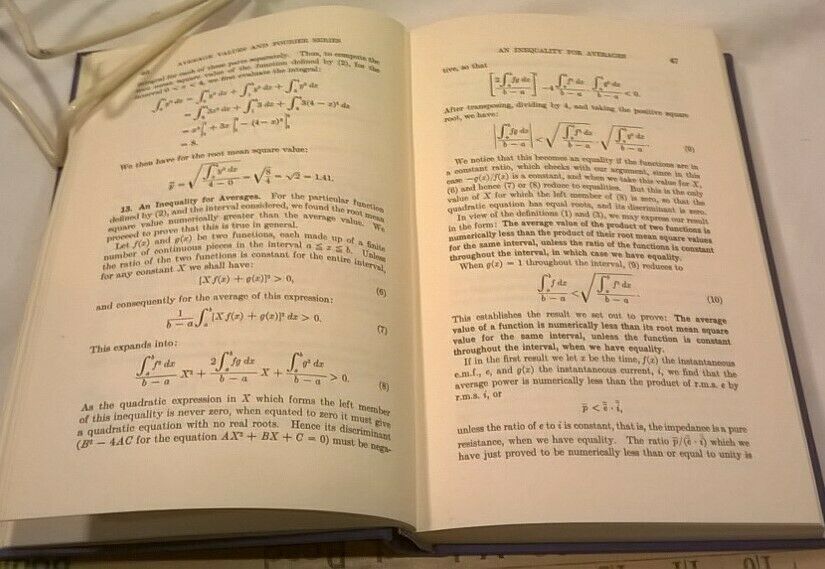Rendered at 15:57:26 08/13/25
Differential Equations for Electrical Engineers by Philip Franklin (1947 HC w/o
Shipping options
Offer policy
OBO - Seller accepts offers on this item.
Details
Return policy
Full refund available within 30 days
Purchase protection
Payment options
PayPal accepted
PayPal Credit accepted
Venmo accepted
PayPal, MasterCard, Visa, Discover, and American Express accepted
Maestro accepted
Amazon Pay accepted
Nuvei accepted
Shipping options
Offer policy
OBO - Seller accepts offers on this item.
Details
Return policy
Full refund available within 30 days
Purchase protection
Payment options
PayPal accepted
PayPal Credit accepted
Venmo accepted
PayPal, MasterCard, Visa, Discover, and American Express accepted
Maestro accepted
Amazon Pay accepted
Nuvei accepted
Item traits
| Category: | |
|---|---|
| Quantity Available: |
Only one in stock, order soon |
| Condition: |
Unspecified by seller, may be new. |
| Binding: |
Hardcover |
| Special Attributes: |
1st Edition |
| Topic: |
Science & Medicine Engineering |
| Year Printed: |
1947 |
| Country/Region of Manufacture: |
United States |
| Language: |
English |
| Original/Facsimile: |
Original |
| Place of Publication: |
New York, NY U.S.A. |
| Modified Item: |
No |
| Author: |
Philip Franklin (1898–1965) |
| Subject: |
Mathematics |
| Publisher: |
John Wiley & Sons, Inc. |
Listing details
| Seller policies: | |
|---|---|
| Shipping discount: |
Shipping weights of all items added together for savings. |
| Posted for sale: |
More than a week ago |
| Item number: |
857755953 |
Item description
Differential Equations for Electrical Engineers by
Philip Franklin (1947 HC w/o DJ)
Author:
Philip Franklin (1898–1965)
Publisher:
John Wiley Sons, Inc. New York, NY U.S.A. 1933
Textbook developed by one of America's
premier 20th century mathematicians. During the 1920s, Dr. Franklin
taught a junior level course in differential equations for electrical
engineering students (summarized in 1st 6 chapters). Then in the
final two chapters, he develops the framework and theorems which
prove why those techniques work and indicate how to solve such
problems with more general methods, thus presenting a basic
introduction to modern Mathematical Analysis in 61 pages.
Book includes 46 sets of exercises for
the reader, answers to select problems, bibliography, and index. vii
+ 299pp. 1933 publication date.
Philip Franklin (1898–1965) was an
American mathematician and professor whose work was primarily focused
in mathematical analysis.
Dr. Franklin received a B.S. in 1918
from City College of New York (who later awarded him its Townsend
Harris Medal for the alumnus who achieved notable postgraduate
distinction). He received his M.A. in 1920 and Ph.D. in 1921 both
from Princeton University. His dissertation, The Four Color
Problem, was supervised by Oswald Veblen. After teaching for one
year at Princeton and two years at Harvard University (as the
Benjamin Peirce Instructor), Franklin joined the Massachusetts
Institute of Technology Department of Mathematics, where he stayed
until his 1964 retirement.
In 1922, Franklin gave the first proof
that all planar graphs with at most 25 vertices can be four-colored.
In 1928, Franklin gave the first description of an orthonormal basis
for L([0,1]) consisting of continuous functions (now known as
"Franklin's system"). In 1934, Franklin disproved the
Heawood conjecture for the Klein bottle by showing that any map drawn
on the Klein bottle can be colored with at most six colors. Perhaps
his most famous result is an example which shows that six colors may
be needed is the 12-vertex cubic graph now known as the Franklin
graph.
Hardcover has blue cloth boards, silver
lettering on spine, front cover empressed with Wiley seal, but no DJ.
This copy was privately owned, but not by a student studying a
course. This book spent most of its existence on a shelf, square
corners and looks better than most copies of any books on the shelves
of a new book store. Most likely an instructor copy or a sales
sample. Interior is tight, clean and unmarked, no ownership.
Size: 8vo - over 7 - 9"
tall, 306pp
Condition:
Fine (As New) Hardcover w/o DJ
–
Always privately owned. 1st
Edition, later printing.
Copyright
1933. Stated from sixth printing, October, 1947. First Edition
(except for having the correction of any initial errata) assumed.
Printed in U.S.A. No ISBN, LCCN, nor MSR.
Notes on
Condition/Edition
ratings:
Fine – means like new, but any
book produced over 10 years ago isn't “brand new” or even “new.”
Booksellers needed some word to describe this...
Like New – A new book, no
marks no damage (except maybe remainder marks or shelf-wear) except
not obtained directly from the publisher or in packaging from the
publisher.
Very Good – How you or I might
take care of a book, closer to “as new” than standard. Might show
ownership.
Good – How someone else might
take care of a book. Also referred to as “standard.” This is the
most likely condition for books of this age title, shows the
book has been read or previously owned.
Acceptable – How a child,
student or a librarian might take care of a book. (Either trying to
make sure someone doesn't steal it by plastering ownership
everywhere, filled it with copious notes or a book that has been
damaged.)
Poor – Combination of
“acceptable” factors above. Most likely with water damage as
well. Might have
missing pages (you should ask).
Near – Means “almost” in
an optimistic sense. e.g., “Near Fine” means very good, but on
the high end.
1st
Thus
– Unique somehow, maybe 1st
paperback,
new illustrator, misprint or even the 1st
edition.
A collector
might desire this copy.
Thanks
for looking!
Added to your wish list!

- Differential Equations for Electrical Engineers by Philip Franklin (1947 HC w/o
- 1 in stock
- Price negotiable
- Handling time 2 days. Estimated delivery: Tue, Aug 26th
- Returns/refunds accepted
Get an item reminder
We'll email you a link to your item now and follow up with a single reminder (if you'd like one). That's it! No spam, no hassle.
Already have an account?
Log in and add this item to your wish list.


















